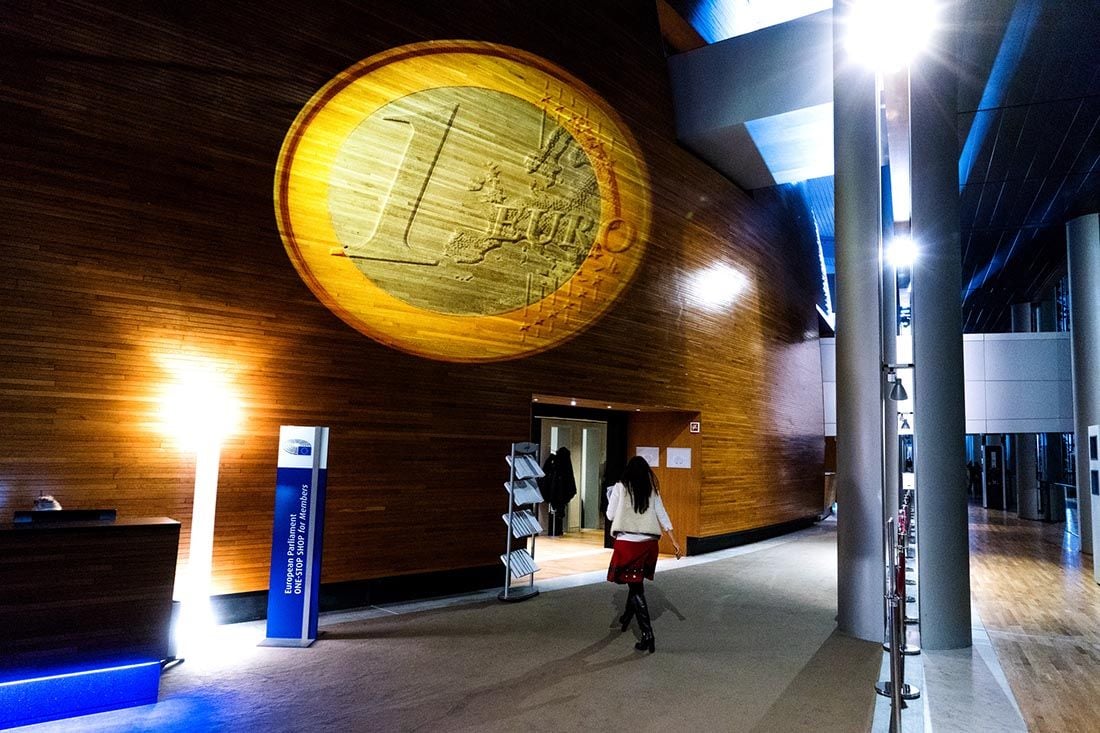Euro-Dollar Rate Tests Trendline as Industrial Data Leaves Forecasters Undeterred
- Written by: James Skinner
-

Image © European Union 2018 - European Parliament, Reproduced Under CC Licensing.
- EUR testing 5-year trendline on charts says Commerzbank.
- Bias to upside but factory data reminds of economic weakness.
- German industrial production bodes ill for final quarter growth.
- But Pantheon sees recovery in store for first half of next year.
- Says rise to 1.20 more likely next year than fall toward parity.
The Euro-Dolllar rate was attempting to break above a key five-year trendline on the charts Friday even after October's industrial production figures pointed to weak final quarter for the Germany economy, and the single currency is tipped by both technical analysts as well as economists for gains next year.
Germany's industrial sector struggled again early in the final quarter, with industrial production falling an annualised 1.7% in October according to Destatis figures released Friday. That deepened a 0.6% contraction from September and came as markets were looking for a 0.1% increase in output.
Production of 'intermediate' and consumer goods was up in October but gains were more than offset by declines in capital goods output. Intermediate and capital goods are both used in the process of producing other goods.
"So-called Nowcast GDP models will look horrible after this headline, pointing to a large contraction in Q4, but they’re really less than useful at this point in the quarter. We need to see the November reports to get a clearer picture. It is fair to say, though, that the German economy is not out of the woods yet" says Claus Vistesen, chief Eurozone economist at Pantheon Macroeconomics.

Above: Euro-to-Dollar rate shown at 4-hour intervals.
The Euro was undamaged by the figures, although the data may not bode well for the final quarter performance of a German economy that has slowed sharply over the last year amid a steep and ongoing downturn in the industrial sector.
The downturn has roots in the U.S.-China trade war, uncertainty over Brexit and new EU rules adversely impacting car manufacturers.
Friday's numbers come hard on the heels of a 0.4% October fall in German factory orders and retail sales figures that showed Eurozone consumers becoming more reluctant to spend that same month.
"We don’t want to sugar coat these data, but the chart shows that the trend in production growth isn’t getting worse, a message supported by the stabilising trend in new orders, albeit at a very depressed pace. We reckon Q4 will be another write-off for manufacturing before a gradual upturn in H1 next year," says Pantheon's Vistesen.

Above: Pantheon Macroeconomics graph showing German industrial production alongside factory orders.
The ongoing slowdown could be said to vindicate the European Central Bank (ECB) for having decided in September to cut its deposit rate from -0.4% to -0.5% and to restart its quantitative easing program with the purchase of €20 bn per month of European bonds from November onward. ECB officials are attempting to lift both growth and inflation across the Eurozone as a whole by stimulating the economy with lower borrowing costs.
Friday's data relates to a month in which German factory orders were said to have rebounded and a period in which IHS Markit PMI surveys showed signs of stabilisation. October's Leibniz Institute for Economic Research (Ifo) survey showed manufacturers becoming more pessimistic about their 'current situation' but less downbeat on the six-month outlook. Meanwhile, the manufacturing PMI rebounded from 41.9 to 42.1, its second consecutive increase.
For the Euro, fundamental analysts say the ECB will need to be succesful in its economic revival venture before the single currency is able to sustain a recovery against the Dollar over any meaningful time frame. But one influential technical analyst, who studies trends and momentum on the charts, said Friday that Europe's unified unit could reverse some of its 2019 loss a lot sooner than that.
"EUR/USD is poised to challenge the 5 month downtrend at 1.1115. Attention is on the topside and the downtrend guards the 1.1180 October high and the 1.1249 channel resistance and eventually the 1.1359 200 week moving-average. This latter level remains the critical break point on the topside," says Karen Jones, head of technical analysis at Commerzbank.

Above: Euro-to-Dollar rate shown at daily intervals.
Jones, who led Commerzbank's team of technical analysts to the top spot in the 2019 Euromoney FX survey rankings, is betting on an increase in the Euro-to-Dollar rate and is of the view that Europe's single currency should retain an upside bias over both the short as well as long-term. The battle to clear the 1.1180 resistance on the charts could dominate the next three weeks or so while the next quarter is expected to yield further technical confirmation the Euro has established a long-term 'base' this year.
Her expectations, although derived from different disciplines of analysis, are in harmony with those of Pantheon's Vistesen. He said this week the Euro is more likely to see a recovery in the months ahead than it is to suffer meaningful losses. Gains will not be of the order seen in past upturns like those of 2017 and 2007, but the path of least resistance is to the upside for the single currency.
Pantheon says the record low level of the German manufacturing PMI relative to the global index, upward movements in the trade-weighted Euro and growth in the 'M1' money supply all point to gains ahead for the Euro-to-Dollar rate. And so too does the November 2020 U.S. presidential election, which will see the re-election prospects of a Dollar-positive President Donald Trump challenged by Dollar-negative Democratic Party candidates and economic policies.
"With the prospects of Elizabeth Warren clinching the Democratic nomination now fading, we don’t want to overplay the political risk across the pond. But our final chart does show that measured political uncertainty in the U.S. is increasing relative to the euro area. This, and the other evidence presented in this Monitor, won’t be enough to drive a +20% rally in EURUSD. But assuming that it will make a move soon, we think 1.15-to-1.20 is more likely than a plunge into the abyss, to parity and below," Vistesen wrote, in a note to clients.

Above: Relative difference in measured EU-U.S. political uncertainty and EUR/USD. Source: Pantheon Macroeconomics.
Time to move your money? The Global Reach Best Exchange Rate Guarantee offers you competitive rates and maximises your currency transfer. Global Reach can offer great rates, tailored transfers, and market insight to help you choose the best times for you to trade. Speaking to a currency specialist helps you to capitalise on positive market shifts and make the most of your money. Find out more here.
* Advertisement





